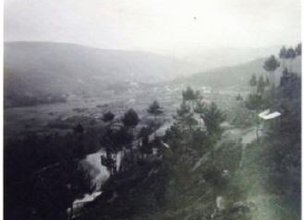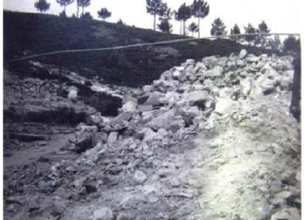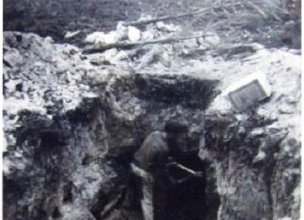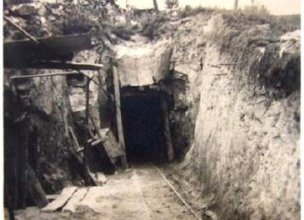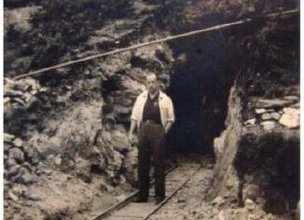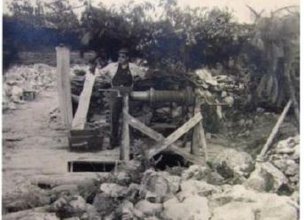Mineral deposits and geomining heritage
Mineral deposits
Mineral deposits are natural concentrations rich in certain chemical elements that can be important from the economic point of view. Mineral deposits might have different origins related to magmatic, metamorphic or sedimentary processes. They are organised as syngenetic when their origin is contemporaneous of the mother rock, and epigenetic when it occurs after the mother rock was formed.
Mineral deposits existing in this LNM are of syngenetic-type. They were formed when hydrothermal fluids circulated through rock fractures during the last stages of crystallization of granitic rocks (esq. A).
Hydrothermal fluids are essentially hot water that exists in depth and contains minerals and other chemical compounds dissolved from the rocks through which it passes or from the cooling magma. As these fluids cool down, they release the dissolved chemical compounds and originate mineral deposits. In the area of the LNM and surroundings there are mineral deposits containing gold, silver, tungsten (wolfram), and tin (cassiterite).
Economic exploitation of mineral deposits
The existence of mineral deposits in a given region does not necessarily mean that they can be economically exploited because this depends on several factors. Natural aspects, such as the type of 95 geological formation where the deposits are located, and climate may be a serious conditioning. On the other hand, the very characteristics of the deposits and especially the concentration of chemical elements are determining: usually, higher concentrations make exploitation more profitable. The deposits must also be large enough otherwise costs related to the transportation and use of technology and equipment become unbearable.
The way in which mineral deposits are exploited is also significant: in general, the exploitation in quarries is cheaper than underground mining. The mean value of the workers’ wages must also be taken into account.
The exploitation of mineral deposits depends on the economic use given to those materials that are taken from them. Social and cultural changes usually imply different needs of raw materials leading to the rise on the demand of certain minerals. Mineral resources are thus a commodity with a high commercial and strategic value, and their market price may vary greatly depending on supply and demand and on the existence of commercial treaties between countries.
This set of factors makes mining activity extremely dynamic both in space and time. Certain regions might prosper during certain years but economic decline might happen if the mining activity decreases or is interrupted.
Geomining heritage
Human population always depended on the use of rocks and minerals for its own survival. Traces of historical mining are a valuable heritage since it gives us information on the habits and activities of ancient communities. These traces are named mining heritage and they may be quite diverse: equipment and buildings, graphic records, written and oral testimony, changes in the landscape, quarries and mining galleries, mine waste dumps, and others. Sometimes, rocks and minerals that have been exploited can be found along with these traces; when this happen we call it geomining heritage. Geomining heritage is quite often associated with industrial heritage, particularly when remaining mining equipment and facilities still exist. In Portugal, traces connected to the exploitation of gold by Romans, and more recently to the exploitation of wolfram in the middle of the 20th century are quite common in certain regions (Figs. 1A to 1F).
Due to environmental, social and visual impacts, traces of ancient mining are many times considered as negative. However, this situation is slowly changing and mining traces are becoming more and more considered as a promising educational and touristic resource which can bring economic and social revenue to local communities.
References:
Pereira, P; Henriques, R.; Brilha, J. & Pereira, D.I. (2019). Conteúdos científicos para a caracterização dos 8 monumentos naturais locais” enquadrado no projeto Geoparque Litoral de Viana do Castelo – 2ª fase. Município de Viana do Castelo, Relatório Final GEOSITE, 273 p.
Mineral deposits
Mineral deposits are natural concentrations rich in certain chemical elements that can be important from the economic point of view. Mineral deposits might have different origins related to magmatic, metamorphic or sedimentary processes. They are organised as syngenetic when their origin is contemporaneous of the mother rock, and epigenetic when it occurs after the mother rock was formed.
Mineral deposits existing in this LNM are of syngenetic-type. They were formed when hydrothermal fluids circulated through rock fractures during the last stages of crystallization of granitic rocks (esq. A).
Hydrothermal fluids are essentially hot water that exists in depth and contains minerals and other chemical compounds dissolved from the rocks through which it passes or from the cooling magma. As these fluids cool down, they release the dissolved chemical compounds and originate mineral deposits. In the area of the LNM and surroundings there are mineral deposits containing gold, silver, tungsten (wolfram), and tin (cassiterite).
Economic exploitation of mineral deposits
The existence of mineral deposits in a given region does not necessarily mean that they can be economically exploited because this depends on several factors. Natural aspects, such as the type of 95 geological formation where the deposits are located, and climate may be a serious conditioning. On the other hand, the very characteristics of the deposits and especially the concentration of chemical elements are determining: usually, higher concentrations make exploitation more profitable. The deposits must also be large enough otherwise costs related to the transportation and use of technology and equipment become unbearable.
The way in which mineral deposits are exploited is also significant: in general, the exploitation in quarries is cheaper than underground mining. The mean value of the workers’ wages must also be taken into account.
The exploitation of mineral deposits depends on the economic use given to those materials that are taken from them. Social and cultural changes usually imply different needs of raw materials leading to the rise on the demand of certain minerals. Mineral resources are thus a commodity with a high commercial and strategic value, and their market price may vary greatly depending on supply and demand and on the existence of commercial treaties between countries.
This set of factors makes mining activity extremely dynamic both in space and time. Certain regions might prosper during certain years but economic decline might happen if the mining activity decreases or is interrupted.
Geomining heritage
Human population always depended on the use of rocks and minerals for its own survival. Traces of historical mining are a valuable heritage since it gives us information on the habits and activities of ancient communities. These traces are named mining heritage and they may be quite diverse: equipment and buildings, graphic records, written and oral testimony, changes in the landscape, quarries and mining galleries, mine waste dumps, and others. Sometimes, rocks and minerals that have been exploited can be found along with these traces; when this happen we call it geomining heritage. Geomining heritage is quite often associated with industrial heritage, particularly when remaining mining equipment and facilities still exist. In Portugal, traces connected to the exploitation of gold by Romans, and more recently to the exploitation of wolfram in the middle of the 20th century are quite common in certain regions (Figs. 1A to 1F).
Due to environmental, social and visual impacts, traces of ancient mining are many times considered as negative. However, this situation is slowly changing and mining traces are becoming more and more considered as a promising educational and touristic resource which can bring economic and social revenue to local communities.
References:
Pereira, P; Henriques, R.; Brilha, J. & Pereira, D.I. (2019). Conteúdos científicos para a caracterização dos 8 monumentos naturais locais” enquadrado no projeto Geoparque Litoral de Viana do Castelo – 2ª fase. Município de Viana do Castelo, Relatório Final GEOSITE, 273 p.
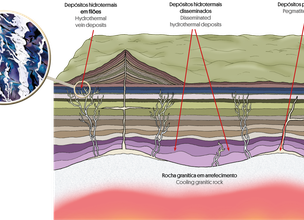
Esq. A - Formation of mineral deposits associated with magmatic rocks.
Location
Amonde
Coordinates
Lat: 41.7717246
Long: -8.7439765
Hello little one!
I'm Piquinhos and I can help you learn more about the Geopark!
Technical details
Esq. A - Formation of mineral deposits associated with magmatic rocks.
Child Mode
Discover the geopark in a simpler format, aimed at the little ones.
Clique ENTER para pesquisar ou ESC para sair
